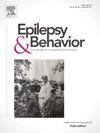经皮耳迷走神经刺激能被认为是治疗耐药癫痫的一种可行的辅助疗法吗?随机对照试验的系统回顾和荟萃分析
IF 2.3
3区 医学
Q2 BEHAVIORAL SCIENCES
引用次数: 0
摘要
目的探讨经皮耳迷走神经刺激(tVNS)作为耐药癫痫(DRE)患者标准医疗护理之外的一种潜在的无创治疗方法。本荟萃分析评估了与假刺激相比,tVNS对DRE患者的疗效和安全性。方法系统检索PubMed、Scopus、Cochrane三个电子数据库,找出比较tVNS与假刺激治疗DRE的随机对照试验(rct)。采用Cochrane随机试验偏倚风险工具进行质量评价。结果共纳入4项随机对照试验,共368例患者,其中tVNS组232例。meta分析显示,tVNS显著降低癫痫发作频率,以月平均癫痫发作次数表示(平均差值[MD] - 3.01, 95%可信区间[CI][- 5.37至- 0.65],p <;治疗结束时癫痫发作减少百分比(MD为17.57%,95% CI [1.90 ~ 33.25], p = 0.03, I2 = 0%)。分析还显示了对应答率的潜在影响(优势比2.00,95% CI [0.98 ~ 4.05], p = 0.06, I2 = 42%),尽管没有统计学意义。两组在癫痫发作自由度、抑郁和生活质量方面无显著差异。报告的不良事件大多是轻微和短暂的,两组之间没有显著差异,停药率也没有可比性。结论本荟萃分析支持tVNS作为DRE辅助治疗的有效性和安全性。由于在一些纳入的研究中存在重大的方法学问题,需要精心设计的随机对照试验来研究tVNS对DRE患者癫痫发作和非癫痫发作结局的疗效。本文章由计算机程序翻译,如有差异,请以英文原文为准。
Can transcutaneous auricular vagus nerve stimulation be considered a viable adjuntive therapy in drug-resistant epilepsy? A systematic review and meta-analysis of randomized controlled trials
Objective
Transcutaneous auricular vagal nerve stimulation (tVNS) has been investigated as a potential non-invasive therapy in addition to standard medical care in patients with drug-resistant epilepsy (DRE). This meta-analysis evaluates the efficacy and safety of tVNS compared to sham stimulation in patients with DRE.
Methods
A systematic search was conducted in three electronic databases (PubMed, Scopus, Cochrane) to identify randomized controlled trials (RCTs) comparing tVNS versus sham stimulation for the treatment of DRE. The Cochrane risk of bias tool for randomized trials was utilized for quality assessment.
Results
Four RCTs, comprising 368 patients, with 232 patients in the tVNS group, were included. The meta-analysis revealed that tVNS significantly reduces seizure frequency, as expressed by mean monthly seizure number (mean difference [MD] −3.01, 95 % confidence interval [CI] [−5.37 to −0.65], p < 0.01, I2 = 0 %) and percentage seizure reduction (MD 17.57 %, 95 % CI [1.90 to 33.25], p = 0.03, I2 = 0 %) at the end of treatment. The analysis also indicated a potential effect on responder rate (odds ratio 2.00, 95 % CI [0.98 to 4.05], p = 0.06, I2 = 42 %), although not statistically significant. No significant differences between groups were found regarding seizure freedom, depression, and QOL. Adverse events reported were mostly mild and transient, with no significant differences between groups and comparable discontinuation rates.
Conclusions
This meta-analysis supports the efficacy and safety of tVNS as an adjunctive therapy for the treatment of DRE. Due to significant methodological concerns in some of the included studies, well-designed RCTs are needed to investigate the efficacy of tVNS on seizure and non-seizure outcomes in patients with DRE.
求助全文
通过发布文献求助,成功后即可免费获取论文全文。
去求助
来源期刊

Epilepsy & Behavior
医学-行为科学
CiteScore
5.40
自引率
15.40%
发文量
385
审稿时长
43 days
期刊介绍:
Epilepsy & Behavior is the fastest-growing international journal uniquely devoted to the rapid dissemination of the most current information available on the behavioral aspects of seizures and epilepsy.
Epilepsy & Behavior presents original peer-reviewed articles based on laboratory and clinical research. Topics are drawn from a variety of fields, including clinical neurology, neurosurgery, neuropsychiatry, neuropsychology, neurophysiology, neuropharmacology, and neuroimaging.
From September 2012 Epilepsy & Behavior stopped accepting Case Reports for publication in the journal. From this date authors who submit to Epilepsy & Behavior will be offered a transfer or asked to resubmit their Case Reports to its new sister journal, Epilepsy & Behavior Case Reports.
 求助内容:
求助内容: 应助结果提醒方式:
应助结果提醒方式:


